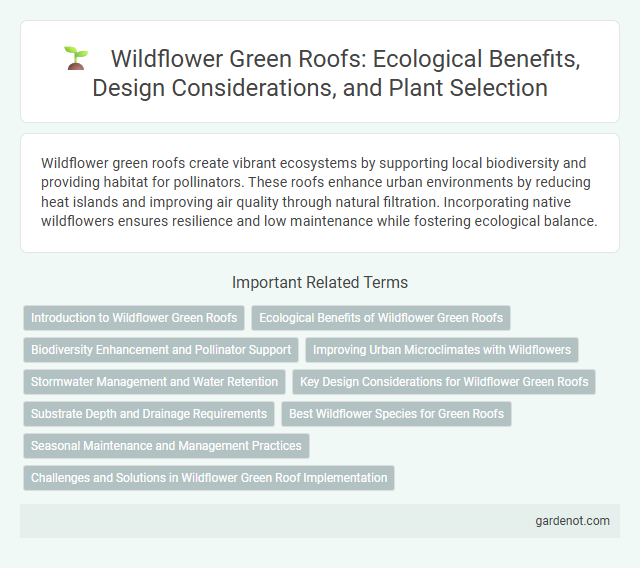Wildflower green roofs create vibrant ecosystems by supporting local biodiversity and providing habitat for pollinators. These roofs enhance urban environments by reducing heat islands and improving air quality through natural filtration. Incorporating native wildflowers ensures resilience and low maintenance while fostering ecological balance.
Introduction to Wildflower Green Roofs
Wildflower green roofs are vegetative layers planted primarily with native wildflower species, promoting biodiversity and creating habitats for pollinators such as bees and butterflies. These roofs enhance urban ecosystems by improving air quality, managing stormwater runoff, and reducing roof surface temperatures through natural insulation. Incorporating a variety of wildflower species supports ecological resilience and increased aesthetic value in urban environments.
Ecological Benefits of Wildflower Green Roofs
Wildflower green roofs enhance urban biodiversity by providing essential habitat and food sources for pollinators such as bees and butterflies. These roofs improve air quality by filtering airborne pollutants and reducing the urban heat island effect through natural insulation. Moreover, wildflower green roofs contribute to stormwater management by absorbing rainfall, reducing runoff, and mitigating flooding risks in densely populated areas.
Biodiversity Enhancement and Pollinator Support
Wildflower green roofs significantly enhance urban biodiversity by providing habitats for various native plant species and supporting diverse insect populations. These roofs create crucial pollinator corridors, attracting bees, butterflies, and other beneficial insects essential for local ecosystem health. By increasing floral diversity and offering continuous bloom cycles, wildflower green roofs promote pollinator activity, contributing to improved pollination in surrounding green spaces.
Improving Urban Microclimates with Wildflowers
Wildflower green roofs enhance urban microclimates by increasing biodiversity and reducing ambient temperatures through natural evapotranspiration. These roofs absorb rainwater, mitigating urban heat island effects and improving air quality by filtering pollutants. Implementing wildflower species tailored to local climates maximizes cooling benefits and supports pollinator populations in dense city environments.
Stormwater Management and Water Retention
Wildflower green roofs significantly enhance stormwater management by absorbing and retaining up to 75% of rainfall, reducing urban runoff and minimizing flood risks. Their diverse plant species and substrate layers increase water retention capacity, promoting natural filtration and gradual release of water. This sustainable design alleviates pressure on municipal drainage systems while improving water quality and supporting urban biodiversity.
Key Design Considerations for Wildflower Green Roofs
Key design considerations for wildflower green roofs include selecting native, drought-tolerant wildflower species that support local pollinators and enhance biodiversity. Adequate soil depth, typically between 4 to 6 inches, ensures sufficient water retention and root establishment for resilient plant growth. Incorporating proper drainage systems and maintenance plans optimizes plant health while preventing erosion and structural stress on the building.
Substrate Depth and Drainage Requirements
Wildflower green roofs require a substrate depth typically ranging from 10 to 15 centimeters to support diverse native plant species and promote healthy root development. Proper drainage systems are essential, including layers such as a drainage board or gravel to prevent waterlogging and ensure efficient runoff. Optimized substrate composition with materials like lightweight aggregates enhances moisture retention while facilitating adequate aeration for wildflower ecosystems.
Best Wildflower Species for Green Roofs
Selecting the best wildflower species for green roofs involves prioritizing drought-tolerant, low-maintenance plants such as Sedum, Echinacea, and native grasses that thrive in shallow soil and exposed conditions. These species contribute to biodiversity by supporting pollinators like bees and butterflies while enhancing roof insulation and stormwater management. Incorporating region-specific wildflowers ensures optimal growth, resilience, and ecological benefits for sustainable green roof systems.
Seasonal Maintenance and Management Practices
Wildflower green roofs require seasonal maintenance that includes periodic weeding to prevent invasive species from overtaking native plants and ensuring optimal biodiversity. Regular inspection during spring and fall promotes healthy growth by addressing drainage issues and replenishing soil nutrients with organic mulch. Effective management practices involve adaptive irrigation schedules to accommodate varying rainfall and temperature patterns, supporting resilient wildflower proliferation year-round.
Challenges and Solutions in Wildflower Green Roof Implementation
Wildflower green roofs face challenges such as plant establishment difficulties, variable climate conditions, and maintenance complexity. Selecting drought-tolerant native wildflower species reduces irrigation needs, while engineered lightweight substrates improve drainage and root support. Implementing adaptive maintenance plans with seasonal monitoring enhances plant survival and biodiversity on wildflower green roofs.
Wildflower green roof Infographic

 gardenot.com
gardenot.com